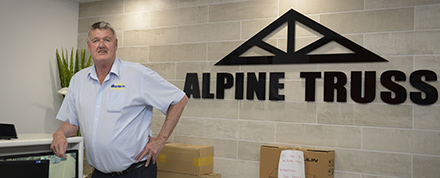
Alpine Truss managing director George Prothero said the business has been unable to address a staffing shortage
Labour shortages are still a real challenge for local businesses with a Wangaratta manufacturing company turning to machines to fill the void. Source: Wangaratta Chronicle
Alpine Truss in Wangaratta invested more than $2.7 million to extend its business footprint and purchase machinery that will effectively replace unavailable human resources.
While Victoria’s unemployment rate sits at a 50-year historically low 3.5%, it doesn’t mean there aren’t any jobs out there for people locally.
Company managing director George Prothero said the building industry is facing a “massive downturn” in the next six months, but he still has jobs available for people right for the job.
“The housing market is definitely slowing so the need for more employees is not as critical as it was; however, we still have scope to employ 12-15 people if they are suitable for the work.
“The business has found that numerous people, who have submitted their resumes, come in, try out and they don’t want to work.”
In light of not being able to attract a suitable workforce the business secured a building permit for a major $700,000 extension which will house state of the art equipment worth more than $2m.
He said the skeleton of the building is erected and the aim is for machines to be fully operational in the next few weeks.
“The equipment does the sawing and stacking of timber, so it takes out a lot of the manual labour in areas we were struggling to find people to do,” he said.
“We have to continue doing that in other areas of the operation as well.”
The downturn is coming for the building industry with the lofty heights propped up by the HomeBuilders grants in 2020-21 long over, and Mr Prothero said the worst in the last 10 years is forecast off the back of inflation and rising interest rates.
The Reserve Bank’s cash rate is expected to peak at 4.1% in the next few months and stay there for 18 months, thwarting the dreams of many people looking to buy their first home, or at least the home they aspired to buy.
Mr Prothero gave some solid advice to those looking to break-in to the market.
“First home buyers have to start looking at something more affordable instead of these 24-square homes with living rooms, swimming pools and ensuites – they are just not affordable,” he said. “They have to go back to the old school 14-square three-bedroom homes.”





